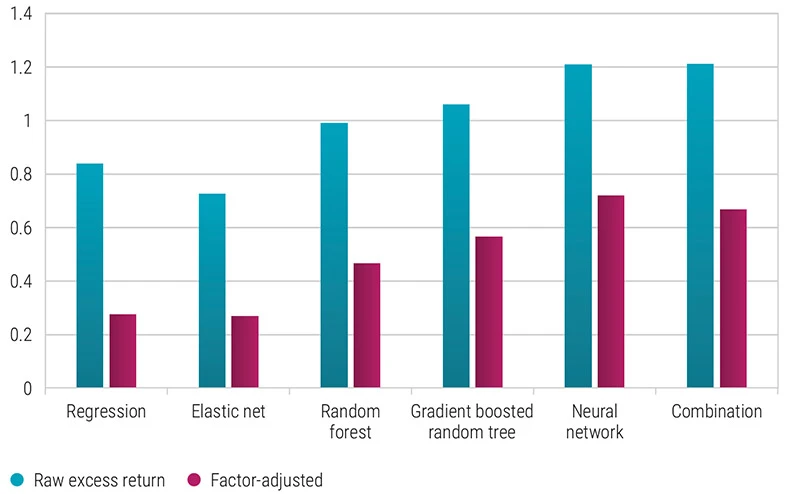Machine learning algorithms have surged in popularity among academics and practitioners as they seek to determine if they can enhance returns. Robeco’s quant team put this to the test by seeing what the application of such algorithms would mean for investing in emerging market equities1. The results were as useful as the machine learning models themselves.
We discovered that they excel at detecting financially material non-linear relationships between company characteristics – a feat that would be challenging for human researchers. We also found that using ensembling, or the ‘wisdom of the crowd’ for machine learning models, could increase expected returns net of trading costs by up to 2% per annum for equity investors.
The results came from analyzing more than 15,000 unique stocks from 32 countries between 1990 and 2021. We used 36 standard characteristics that can apply to both developed and emerging markets for the study, and opted not to introduce any new ones to highlight the added value that machine learning techniques can bring. This ensured that any additional performance gleaned wasn’t just the result of novel data but accrued to well-known factors such as low-risk, valuation, momentum and quality.
Different algorithms were then used to predict relative stock returns to their own country market index based on these factors. The least complex method assumes that each of the firm characteristics has a linear relationship to stocks’ outperformances.
Three machine learning methods were used to improve upon straightforward linear regression.
Elastic net. This method aims to reduce the number of characteristics (36 in our case) by eliminating those with the lowest or no forecasting ability. It also minimizes the potential noise that may be present in a sample that could impair out-of-sample predictive performance. This method does not detect data-driven non-linear relationships or interaction effects.
Tree-based methods. Random forests and gradient-boosted regression trees follow the idea of sequentially partitioning the underlying data into groups of firm characteristics – ‘growing’ a tree. New branches are created every time the data is separated. At each new branch, the characteristic that generates the biggest separation in the database is selected, with the tree growing as high as the researcher allows, ending in a leaf.
Neural networks. These are flexible models that connect multiple layers. They consist of an input layer of firm characteristics and at least one hidden layer of activation functions. An output layer aggregates the hidden layers’ outcomes into a return prediction. When a model uses more than one hidden layer – ours uses up to five – it is sometimes referred to as a deep learning model.
With 1990 to 2001 as our initialization period, we used data from the first half for training and the second half for validation. We trained the models on our entire set of emerging market stock returns and refrained from developing country-specific models, because some evidence suggests these may lead to overfitting, which reduces out-of-sample performance.
We can then rank each of the 36 variables in order of their importance by evaluating the negative impact on prediction performance when the variable is left out and the rest of the model remains unchanged. We found that the models make similar choices regarding the most influential characteristics, with price to its 52-week high, idiosyncratic volatility, and turnover being the three most important.
Momentum and short-term reversal are also among the top 15, as well as the price/earnings ratio and profitability. This is information that is worth having. Detecting interaction effects between each of the 36 variables would be incredibly time-consuming and difficult for a human researcher, whereas a machine learning model is able to find these relationships quickly and systematically.
Investment performance
So they work in theory, but how do these interaction effects actually impact investment performance? For investors, it may be more relevant to back-test the signals coming from these models, allowing us to compare the risk and return of portfolios.
To test this, we formed five portfolios based on the machine-predicted excess returns of each stock relative to its country index. We then calculated the return in the next month, using market capitalization-based portfolio weights within each portfolio. Starting in our out-of-sample period from January 2002, we repeated this each month until December 2021, when our sample ends. The results can be seen in the chart below.

Source: Robeco, Hanauer and Kalsbach (2023) using data from January 2002 to December 2021
On average, the returns of the long/short portfolio derived from the two linear models, namely regression and elastic net, were around 0.8% per month. This is substantial and shows that conventional quantitative models are able to generate excess returns in emerging stock markets, confirmed by earlier studies on factor investing in emerging markets.
The random forest and gradient-boosted random tree methods generated higher returns of around 1.0% per month, while the neural networks method and a combination of all machine learning models delivered 1.2%. In short, linear models are good, but machine learning models are better.
最新のインサイトを受け取る
投資に関する最新情報や専門家の分析を盛り込んだニュースレター(英文)を定期的にお届けします。
Going back to basics
This does lead to the question of whether this is just a fancy way to pick up the conventional quantitative factors that have been employed in the investment industry for decades. Indeed, as the red bars show, a substantial part of the raw excess returns can be explained by these well-known factors.
On the one hand, this confirms that traditional factor investing can still predict future returns. On the other hand, it also shows that machine learning models give us greater, economically important insight that can bring even higher returns. The linear models show there is about 0.2% per month of alpha left to capture, which increases to 0.5% per month for the tree-based models, and 0.7% per month for the neural network method and the machine learning ensemble.
Hence, using machine learning signals is more profitable than conventional factor investing alone. Even accounting for transaction costs and short-selling constraints, we see that this type of forecast can lead to significant net outperformance over the market, and can be recommended to investors.
Footnote
1See Hanauer and Kalsbach (2023), Machine learning and the cross-section of emerging market stock returns, Emerging Markets Review 55 (2023), 101022.
This article is an excerpt of a special topic in our five-year outlook.
Webinar: 5-Year Expected Returns 2024-2028
Our five-year outlook on market opportunities and risks.
重要事項
当資料は情報提供を目的として、Robeco Institutional Asset Management B.V.が作成した英文資料、もしくはその英文資料をロベコ・ジャパン株式会社が翻訳したものです。資料中の個別の金融商品の売買の勧誘や推奨等を目的とするものではありません。記載された情報は十分信頼できるものであると考えておりますが、その正確性、完全性を保証するものではありません。意見や見通しはあくまで作成日における弊社の判断に基づくものであり、今後予告なしに変更されることがあります。運用状況、市場動向、意見等は、過去の一時点あるいは過去の一定期間についてのものであり、過去の実績は将来の運用成果を保証または示唆するものではありません。また、記載された投資方針・戦略等は全ての投資家の皆様に適合するとは限りません。当資料は法律、税務、会計面での助言の提供を意図するものではありません。 ご契約に際しては、必要に応じ専門家にご相談の上、最終的なご判断はお客様ご自身でなさるようお願い致します。 運用を行う資産の評価額は、組入有価証券等の価格、金融市場の相場や金利等の変動、及び組入有価証券の発行体の財務状況による信用力等の影響を受けて変動します。また、外貨建資産に投資する場合は為替変動の影響も受けます。運用によって生じた損益は、全て投資家の皆様に帰属します。したがって投資元本や一定の運用成果が保証されているものではなく、投資元本を上回る損失を被ることがあります。弊社が行う金融商品取引業に係る手数料または報酬は、締結される契約の種類や契約資産額により異なるため、当資料において記載せず別途ご提示させて頂く場合があります。具体的な手数料または報酬の金額・計算方法につきましては弊社担当者へお問合せください。 当資料及び記載されている情報、商品に関する権利は弊社に帰属します。したがって、弊社の書面による同意なくしてその全部もしくは一部を複製またはその他の方法で配布することはご遠慮ください。 商号等: ロベコ・ジャパン株式会社 金融商品取引業者 関東財務局長(金商)第2780号 加入協会: 一般社団法人 日本投資顧問業協会



















